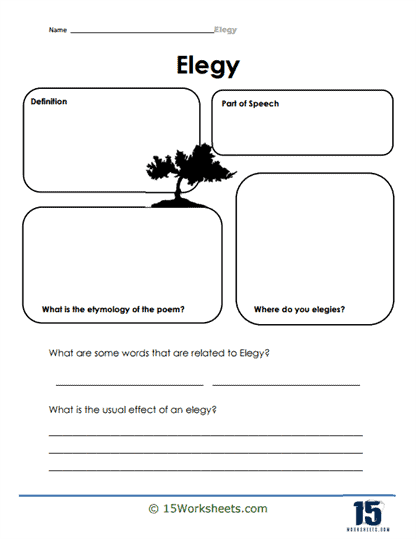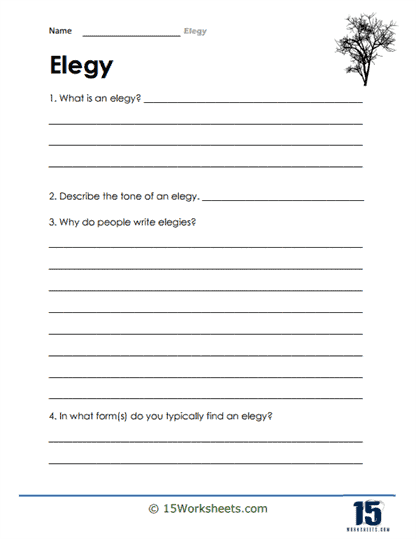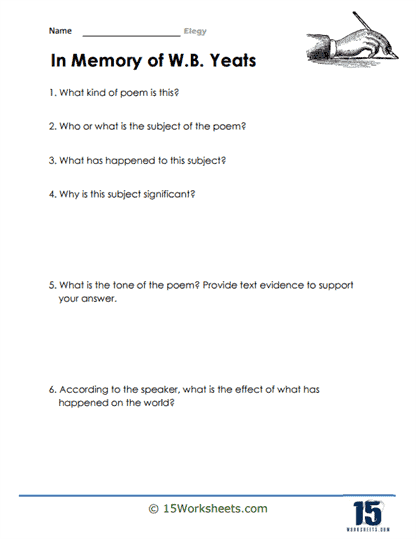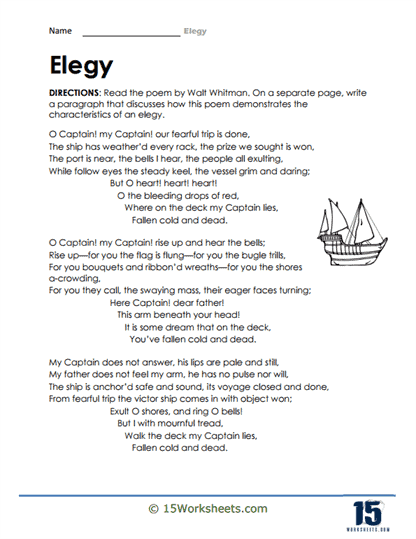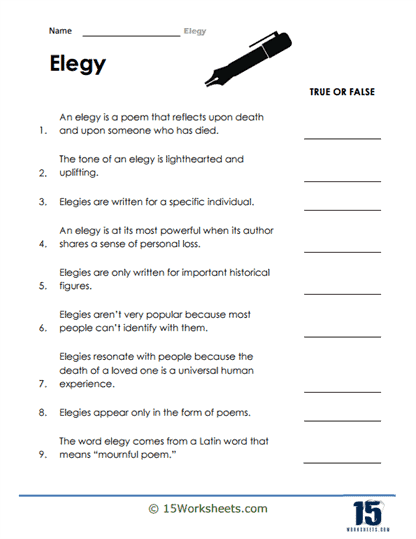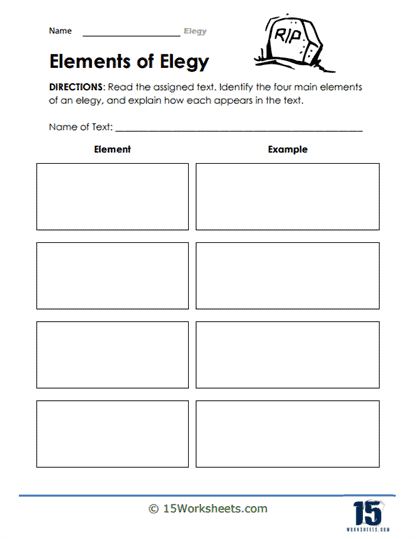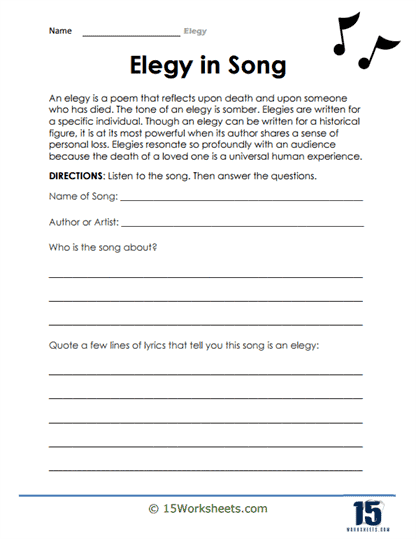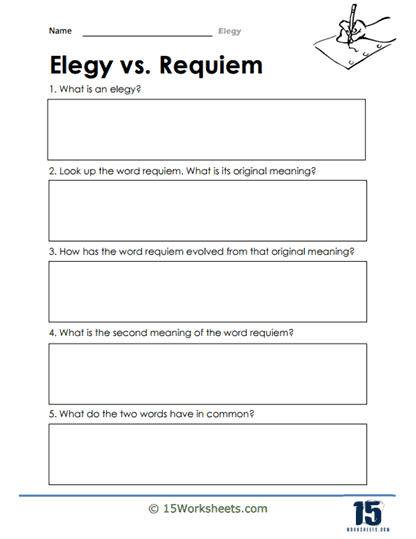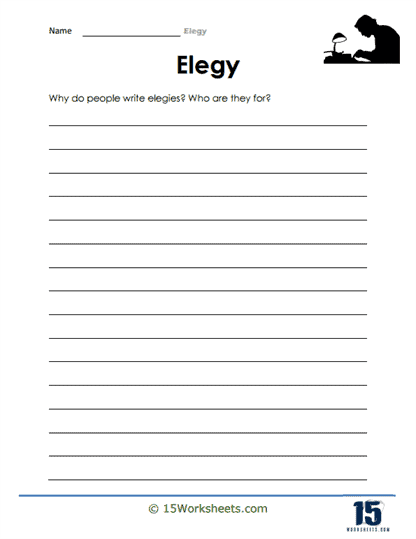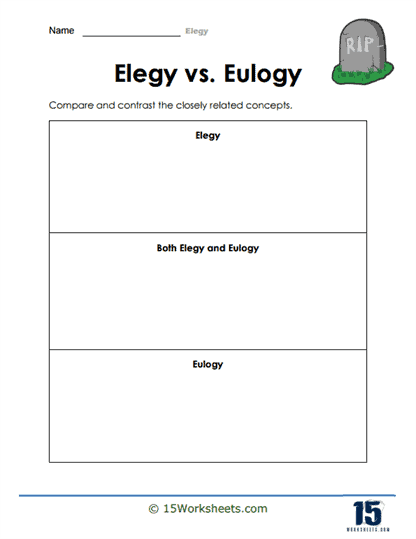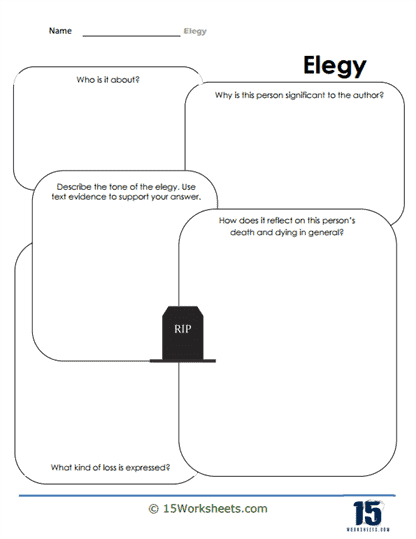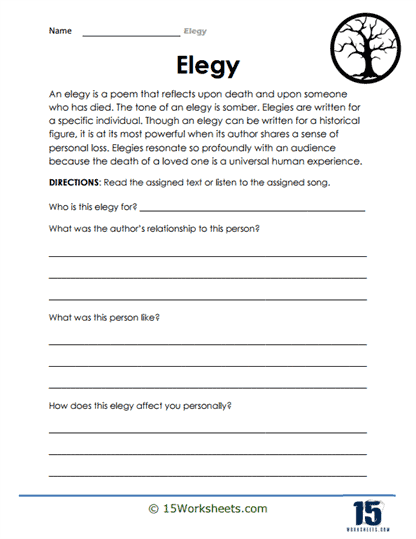Elegy Worksheets
About These 15 Worksheets
These worksheets can help deepen students’ understanding of the elegy, a poetic form that mourns the loss of someone or something and reflects on the nature of that loss. These worksheets offer a variety of exercises tailored to explore the thematic elements, structure, and emotional depth characteristic of elegies. By engaging with these worksheets, students not only enhance their comprehension and analytical skills but also cultivate empathy and a deeper appreciation for the nuances of poetic expression. This exploration will detail the essence of Elegy Worksheets, the diverse exercises they encompass, and how they foster proficiency in language arts and reading.
The worksheets focus on dissecting and understanding elegies, which are poems of mourning that express sorrow over a loss, often commemorating a deceased person but sometimes addressing broader themes of loss like the passing of youth, beauty, or a way of life. These worksheets serve to introduce students to the historical and cultural context of elegies, analyze their themes and structures, and encourage creative engagement with the form.
Through a variety of exercises, these worksheets not only enhance students’ reading and analytical skills but also encourage emotional growth and creative expression. By integrating Elegy Worksheets into their learning, students gain a deeper understanding of the complexities of human emotion and the poetic expression of loss, enriching their overall experience of language arts and equipping them with skills and insights valuable beyond the classroom.
Types of Exercises
Contextual Analysis – Exercises that prompt students to research the historical and cultural background of an elegy to understand its significance and the context in which it was written. This helps students appreciate the poem beyond its text, considering the influence of its time on its themes and style.
Thematic Exploration – Students are asked to identify and analyze the central themes of an elegy, such as grief, loss, the passage of time, and the acceptance of death. This involves close reading and textual analysis to uncover how these themes are developed throughout the poem.
Structural Analysis – These exercises focus on the structure of elegies, including their rhyme scheme, meter, and form. Students learn to examine how the poem’s form contributes to its overall impact and emotional resonance.
Figurative Language Identification – Worksheets may include exercises that task students with identifying and interpreting the figurative language used in elegies, such as metaphors, similes, personification, and symbolism. Understanding these literary devices helps students grasp the deeper meanings and emotions conveyed by the poet.
Comparative Studies – Some worksheets encourage comparing and contrasting different elegies or comparing elegies with other poetic forms. This helps students recognize the unique features of elegies and understand poetry’s diverse expressions of themes like loss and mourning.
Creative Writing Prompts – Encouraging students to write their own elegies based on personal experiences or imagined scenarios allows them to apply their understanding of the form’s conventions creatively. This exercise fosters empathy and personal expression, enabling students to explore their feelings about loss and mourning.
Discussion and Reflection Questions – Worksheets often include questions that prompt reflection on the reading experience and discussion about the poem’s impact. These questions encourage students to articulate their interpretations and engage with the elegy on a personal level.
Performance and Recitation – Exercises that involve reciting elegies aloud help students explore the auditory elements of the poem, such as its rhythm, tone, and the emotional weight of its words. This can deepen their understanding and appreciation of the poem’s aesthetic qualities.
Benefits of These Worksheets
Practicing with Elegy Worksheets offers numerous benefits to students’ development in language arts and reading:
Enhanced Comprehension and Interpretation – By analyzing the themes and structures of elegies, students improve their ability to comprehend complex texts and interpret deeper meanings, a skill transferable to other literary forms.
Critical Thinking and Analytical Skills – The varied exercises on these worksheets encourage students to think critically about the text, evaluating its elements and the poet’s intentions, thereby honing their analytical skills.
Empathy and Emotional Intelligence – Writing and reflecting on elegies allow students to explore their feelings about loss and empathy for others’ experiences, enhancing their emotional intelligence and capacity for empathy.
Creative Expression – Creative writing prompts inspire students to express themselves and explore the therapeutic aspects of writing about loss, contributing to their growth as writers and individuals.
Appreciation for Poetry and Literature – Engaging with elegies exposes students to the richness of poetic expression and the ways in which literature addresses universal human experiences, fostering a lifelong appreciation for poetry and literature.
Improved Writing Skills – Analyzing and writing elegies teach students about the importance of structure, word choice, and literary devices in creating impactful poetry, skills that are invaluable in all forms of writing.
What is the Literary Device of Elegy?
The literary device of an elegy is a profound tool utilized by authors to express mourning and reflect upon loss. This poetic form transcends mere sadness to explore the depths of human emotion, grappling with themes of grief, love, and the inevitable passage of time. Through the use of elegy, writers not only commemorate the departed but also offer solace and insight into the nature of loss itself. This essay will elucidate the essence of the elegy as a literary device, its defining features and characteristics, and the impact it has on readers, illustrated through three poignant examples from literature.
Defining Feature of an Elegy
The main defining feature of an elegy is its thematic focus on mourning and reflection on loss. Unlike other poetic forms that may touch upon a wide array of subjects, the elegy is dedicated to expressing sorrow and lamentation, often for a person who has died but also for the loss of love, youth, or an era. This focus provides a solemn and introspective tone, guiding the reader through the poet’s journey of grief and ultimately, in many cases, to a resolution or consolation.
Characteristics of an Elegy
Mourning and Lamentation – At its core, an elegy expresses grief and sorrow, serving as a poetic mourning for what has been lost.
Admiration and Idealization – Often, the subject of an elegy is idealized, with the poet highlighting their virtues, achievements, or the beauty of what is no longer present.
Reflection and Solace – Elegies typically move from mourning to a reflection on the implications of loss, sometimes offering solace either in the acceptance of mortality or in the celebration of the life that was.
Formal Structure – While not as rigid as other forms, elegies often adhere to a formal structure, using meter and rhyme to convey their solemn tone. However, this can vary widely with the advent of free verse elegies.
Use of Figurative Language – Metaphors, similes, personification, and imagery are commonly used to enrich the text, providing depth and resonance to the emotional landscape being explored.
Examples of Elegy in Literature
“O Captain! My Captain!” by Walt Whitman – This elegy mourns the death of Abraham Lincoln, using the metaphor of a ship and its captain to depict the Civil War and Lincoln’s role in it. The poem oscillates between joy over the end of the war (“our fearful trip is done”) and despair over Lincoln’s assassination (“Fallen cold and dead”). Whitman’s use of an extended metaphor allows him to explore the depths of his grief and the nation’s loss, offering a poignant tribute to Lincoln’s leadership and legacy.
“In Memoriam A.H.H.” by Alfred, Lord Tennyson – Written over 17 years, this extensive elegy commemorates Tennyson’s friend Arthur Henry Hallam, who died suddenly at the age of 22. The poem is notable for its exploration of Tennyson’s grief, doubts, and search for faith. Through its sections, Tennyson wrestles with the harsh reality of death and the possibility of an afterlife, ultimately finding consolation in the enduring power of love and the hope of reunion beyond death. “In Memoriam” is a profound meditation on loss, love, and the quest for meaning in the face of mortality.
“Elegy Written in a Country Churchyard” by Thomas Gray – Gray’s elegy reflects on the lives of common people buried in a rural churchyard, lamenting not just individual loss but the universal inevitability of death. The poem contemplates the unnoticed deaths of the “rude forefathers of the hamlet” and ponders the potential lost to the world because of their obscurity. It moves towards a more personal reflection on the poet’s own mortality, ultimately finding solace in the natural cycle of life and death. Gray’s work is celebrated for its deep humanity, eloquent expression of universal themes, and the serene acceptance of mortality.
Effect of Elegy on the Reader
The impact of an elegy on readers is profound and multifaceted. Firstly, elegies evoke empathy, allowing readers to share in the poet’s sorrow and perhaps find expression for their own grief. The specificity of the poet’s lament invites a universal understanding of loss, creating a shared space of mourning that transcends the personal.
They can also stimulate reflection on the nature of life, death, and the values we hold dear. By confronting mortality, elegies encourage readers to consider what is truly important and how they might honor the memory of those they have lost.
Elegies also offer consolation, not by denying the pain of loss but by situating it within a broader context of love, memory, and the natural cycle of life. This shift from despair to acceptance or hope provides a form of solace to readers, suggesting that while loss is an inescapable part of the human experience, it can also lead to deeper understanding and appreciation of life.
The literary device of the elegy serves as a powerful means for authors to explore themes of loss, mourning, and reflection. Through its focus on lamentation, idealization, and ultimately consolation, the elegy offers readers a profound emotional experience, inviting them to share in the universal human experiences of grief and the search for meaning. Through examples like Whitman’s “O Captain! My Captain!”, Tennyson’s “In Memoriam A.H.H.”, and Gray’s “Elegy Written in a Country Churchyard”, we see the elegy’s capacity to mourn, reflect, and ultimately find solace, underscoring the enduring relevance and emotional power of this literary form.

